KEN SCOTT: ME AND MR. JONES
Legendary record producer and recording engineer, Ken Scott, talks about his work on some of the 20th Century's most renowned albums.
[Download .wmv video message from Ken Scott here]
Barfly: The Great Escape, Spiegel Tent, Brighton, UK
Saturday 20th May, 2006
'Me and Mr Jones' will cover the technicalities, the stories, the history leading to some of the seminal albums of the Seventies from 'Space Oddity' to 'The 1980 Floor Show' and all stops in between.
With such an introduction to the undoubted highlight of the Great Escape three-day event, BowieWonderworld made sure it was there, right up front, as Lou Reed would say. Six lucky BowieWonderworld reporters - TheLodger, Sweetythang, Sunrise, UncleFloyd, Jackie and Mr C - took their seats for what was to prove an illuminating and highly enjoyable 90 minutes with the man responsible for producing and engineering some of the greatest albums in rock history.
For those of us there, piecing together afterwards the joy of those 90 minutes has been a little like a 'New York Telephone Conversation', except it's been an internet conversation. No telephone. Well, there is a telephone, but more of that later.
Here's TheLodger:
I loved the way Ken kicked off the talk by introducing himself and the elusive other chap as being 'two kids brought up in the same part of London' (accompanied by two very early childhood photos of each), and both being 'reined in by two very domineering mothers'.
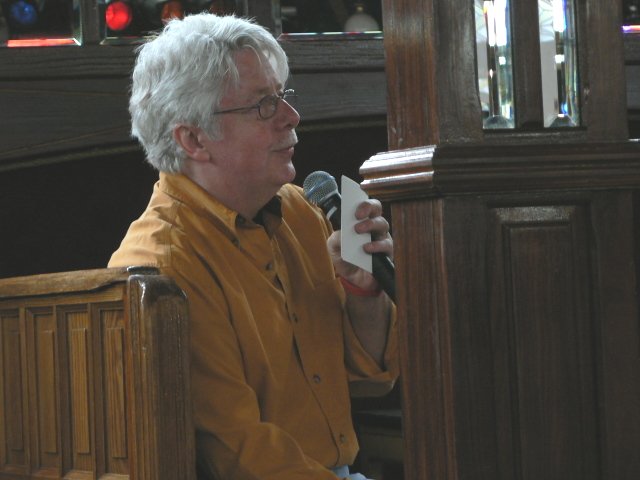
Ken from the sidelines - introducing two young lads from South London born in 1947
One of the first things we were treated to was a ferocious burst of the opening drums to the Beatles' 'Glass Onion' from their White Album, on which Ken was an Engineer no less. It was at that moment that it sunk in just how incredible this man's resume really is... I really did feel humbled for a moment, but he was so down to earth that he was able to cut through the minutiae and yet still explain the process of production so that even a layman would grasp the process. For that I was really grateful, and for me it made the talk priceless. Coupled with that, seeing previously unseen pics (I assume) of him and the Beatles in the studio... well, that really did bring home the bacon if anyone was in any doubt as to just who Mr. Ken Scott is!
JackieC: I agree. It was a fantastic afternoon, and I knew it was going to be good when I heard the opening bars of the Fourth Movement of Beethoven's Ninth floating outside while we waited to go in. Otherwise known as the Wendy Carlos arrangement of what we fans think of as 'Ziggy's' Clockwork Orange. Ken was fabulous, and even though I'm not great at understanding studio-type talk, the examples he gave were presented simply, and with samples of tracks, so that even dimwits like me could understand it. We got a terrific example of the 'spacey' sound before the 'Starman' chorus, where each instrument that was used and overlaid was explained, because apparently that's one of the most frequent questions Ken is asked - 'how did you get that 'morse code' sound?' Ken explained that it was two guitar sections from Mick Ronson, plus piano. He played each section individually and then played the lot as put together in the studio.
Sweetythang: 'Twas a fab time all round. I'm glad (for Lodger's sake if nothing else) that Ken actually got to say 'Hol... as in holes'.
JackieC: That was great! I loved, too, the explanation of how the hierarchy of recording studios operated, when Ken started out as a school leaver. How did he say it worked? I think in those days you started as a 'button pusher', graduated to second engineer, then had to learn to master to vinyl - which you had to learn before you mastered to tape - and then finally they'd let you loose as an engineer proper.
Sweetythang: Brown coat, then white coat, then suit... and occasionally your jacket off, your tie loosened and an orange shirt. To illustrate how the hierarchy worked, Ken explained how various studio personnel wore different modes of dress according to the job they did. Technicians wore brown coats, engineers wore white coats, and producers wore suits. If you were a distinguished producer, you might get to loosen your tie, or take off your jacket. You might even get to wear an orange shirt! Ken showed us a black-and-white photo of himself in the studio with the Beatles, and then, with some technical wizardry, Ken's shirt in the photo blossomed into orange. I thought that was extremely apt, the way that the graduation to orange shirt happened with the Beatles.
Sunrise: Speaking of clothes, didn't Ken mention hot pants?
UncleFloyd: Hot pants - if my memory serves me well, Ken was telling us about a male recording artist who David was producing and who was wearing hot pants in the studio. Ken clearly did not appreciate this fashion choice especially as 'certain parts' were in danger of falling out.
Sunrise: So, BowieWonderworlders, any guesses as to who the guy in hot pants could have been?
Sweetythang and TheLodger: Lou Reed!
Mr C: Noooooo way!
Sweetythang: They could have been leather hot pants. Lou likes leather.
TheLodger: The hot pants artist would be any of this lot: Arnold Corns (Freddie Burretti), Lou Reed, Iggy Pop or Mott The Hoople.
Sweetythang: I liked the video footage Ken showed of Herbie Flowers, where Herbie said he'd suggested that as well as playing the bassline on double bass for Lou Reed's 'Walk on the Wild Side', he could improve it by playing it on electric bass as well, and the two could then be mixed together. Herbie said it was a really simple idea, and that as well as being the first to do it (suggest a bassline played on two instruments), he managed to get double the fee that way. I think Ken said the basic fee would have been £12.
JackieC: As well as getting to see footage of Herbie playing that famous bassline, we were lucky enough to hear Rick Wakeman's piano isolated from the rest of 'Life On Mars?', and played separately - just the piano. It sounded fantastic. I'm usually hopeless at listening to the separate 'threads' of sound. When I listen to a track, I hear it whole, or else I'll hear a solo, but I can't pick out instruments if there's a lot else going on in the background, so to hear Rick's piano, and Bowie's 'one take' stand-alone vocals was a real treat. As was hearing the strings section - shown on the overhead projector as 'string bass, celli, violas, violins 1, violins 2'.
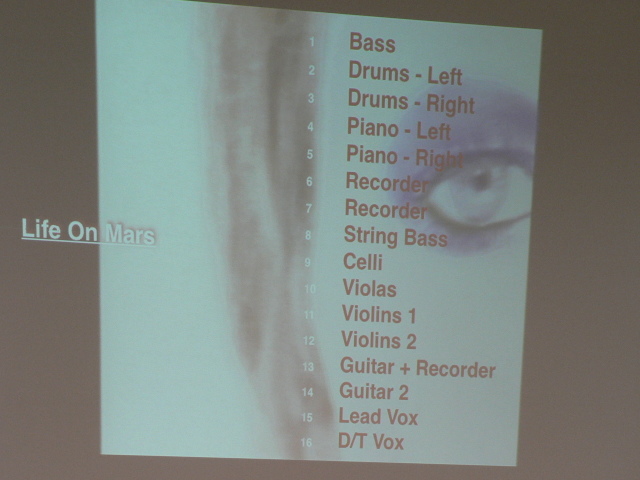
Life On Mars?
TheLodger: Yes, the entire talk was propelled along nicely by an OHP presentation made up of photo slides and montages, live footage, and Ken's own self-made graphics that had the various LPs wrapped around cubes which rotated to thundering soundtracks. The speaker system was pretty impressive, and 'played at maximum volume' - as they used to say on the old LPs.
Hearing 'Life On Mars?' laid bare like that was one the certain highlights for me, if not the highlight. It really was a genuine aural delight. The other such track broken down was 'Rock 'N' Roll Suicide', and hearing Ronno's guitar solo was mind blowing!
The latter track was broken down as follows:
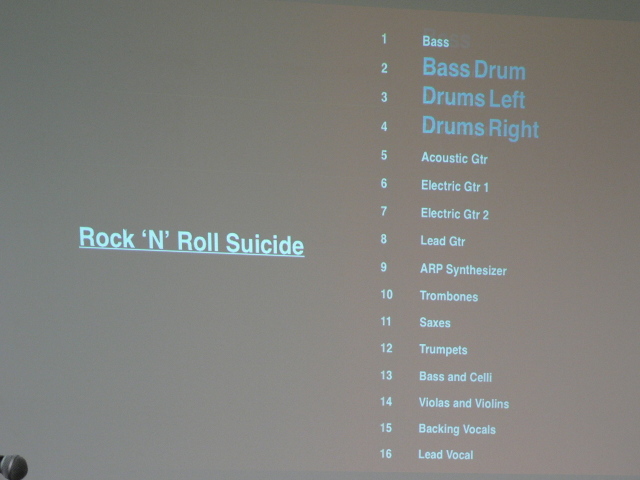
Rock 'N' Roll Suicide
As said, one often just hears the music as a whole, but through analysis as Ken gave, you really do begin to appreciate and listen to the various parts that make up the piece, sort of an inbuilt 5.1 we all have, yet seldom bother to use... and yeah Rick's piano on LOM was pretty special to hear like that!
JackieC: Ken explained how different the recording techniques were in the '70s from the techniques of today. Musicians had to anticipate how they wanted a track to sound before it was played and recorded (for example they only had two microphones for the drum kit - one on the left and one on the right - but on 'Rock 'N' Roll Suicide' they knew how they wanted the drums to sound, so they added a third mic on the bass drum). In those days, if musicians weren't happy with the sound as recorded, then it seems that the whole thing had to be recorded again, pretty much. With only 16 tracks to work with (at Trident), if you used three on the drums, then that limited what you could do elsewhere on the sound.
Sunrise: He also mentioned how commendable Bowie's insistence was that the original people involved with the 'Ziggy Stardust' album, be those that would later go on to mix the 5.1 for the anniversary reissue. Later, in a brief Q&A, he expressed the opinion that it would somehow be the death of 5.1 as many artists are being mixed with no feel for the original magic of certain classic albums, although it has to be said he wasn't at all happy about not being involved with the 5.1 remix of Supertramp's 'Crime Of The Century'.
JackieC: One thing that had me wondering, was how many people involved in the music industry from the 1960s onwards are still in possession of Stylophones! We know that DB has one, Rolf Harris has one, and now we know that Ken still owns one too.
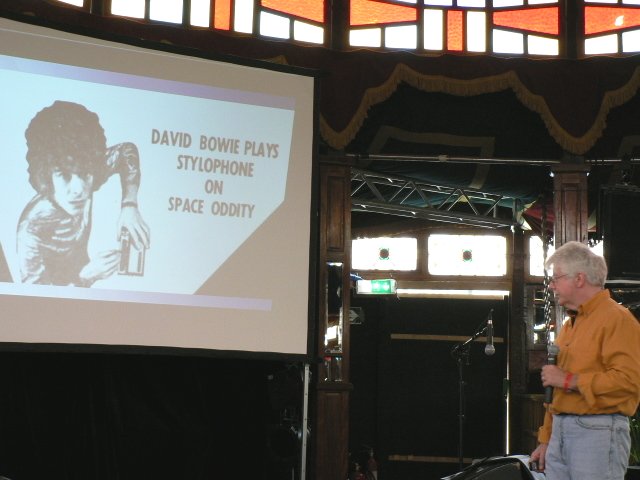
DB plays the Stylophone

Ken plays the Stylophone
Sweetythang: Ken spoke a bit about 'The 1980 Floor Show', and how he was in a studio over the back of the Marquee Club, engineering as it all happened. The studio was also used a dressing room, where Amanda Lear apparently stripped off in front of Ken during a costume change. David said to Ken, 'She's a bit gorgeous, eh?' Ken agreed, only for David to then say, 'especially as she was a bloke six months ago.'
JackieC: Another story concerned the mixing desk at Trident, which had buttons on it which would light up when pressed. Ken explained how engineers would get bored working through the night, and that on one occasion an engineer was pressing all the buttons to make words appear in the lights. By the time he'd got to the last 'f' of 'F**k Off', all the settings were blown. Trident got rid of the lights on the buttons after that. But the best Trident story of all, to my mind anyway, was the one involving the telephone. Over to TheLodger!
TheLodger: Well, that story, of course, relates to the ringing telephone and muffled chat you can hear at the end of 'Life On Mars?'. Ken, instead of playing us the very end of that song, played the few seconds before the 'Kooks' track comes in, and again, he played it at maximum volume. We could clearly hear the telephone ringing, plus the words 'B******s' and 'F**k'. These words were from somebody with a Northern UK accent (possibly Mick Ronson), and you could hear phrases like 'For fook's sake'. Ken showed us a photograph of the studio, and explained that the position of the piano was immediately in front of the studio's toilet door. The telephone, as illustrated by the arrow in the photo below, was almost in the toilets.
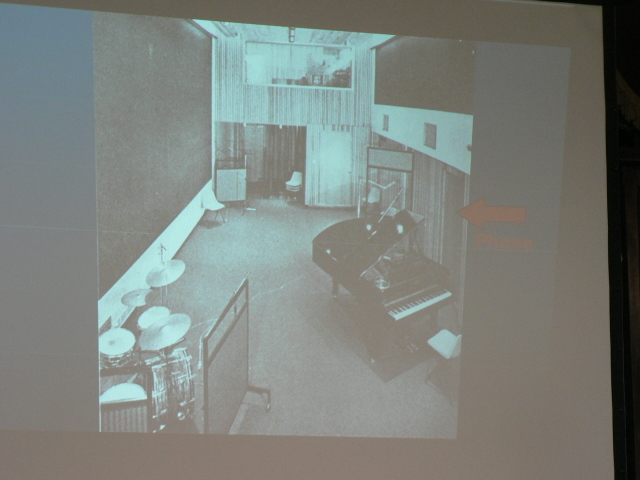
The infamous Trident toilet
JackieC: Never mind the lights on Trident's mixing desk, I think Ken must have seen all of our faces light up when he started that story!
TheLodger: If only we'd asked Ken who was actually ringing that telephone.
Sweetythang: Me, if I'd had anything to do with it.
JackieC: After the delights of hearing extracts from 'Hunky Dory' and 'Ziggy', the talk then progressed to the 'Aladdin Sane' album. A fantastic blast of 'Watch That Man' came over the speakers. 'Can you hear any vocals?' Ken asked, referring to how far back the vocals are mixed on the recording. He explained that during recording, he'd decided the song would sound better if the vocals were back a bit, sort of like a Stones sound, so that was the way he mixed it. Management, however, weren't keen when they heard the tape, so asked Ken to remix it with the vocals more up front. So he did, and management then decided they preferred the original mix (vocals back), so that was the mix that got sent to the record company, RCA. The record company, however, then phoned Ken to say they didn't like it, they wanted the vocal up front, and asked him to do a remix. So he did another one. RCA then decided that, actually, they preferred the original mix, so eventually, it was the original mix that made the album.
So that's three mixes for 'Watch That Man':
The original mix (vocal back), which is on the album.
The management mix (vocals up front).
The record company mix (vocals up front, different from the management mix).
TheLodger: Ken described this as one of his 'cock-ups', and that he momentarily lost sight that 'Aladdin Sane' was a David Bowie LP, and thus David's vocal should always be at the forefront, not hidden within the mesh of instruments. Whatever his professional opinion, I think he's being too harsh on himself; in fact the layered vocal adds to the whole raw 'n' live feel of 'Watch That Man', not unlike 'Cracked Actor'.
JackieC: Very well put, TheLodger! I agree. I wouldn't want that track to be any other way.
TheLodger: It was great that after the talk was finished, we were treated to a Q&A session with Ken. I asked - 'Besides Elvis Presley (as he'd already mentioned him being his idol), which artist, past or present, would you like or have liked to work with?' The answer was surprising, but then Ken has this endearing quality that harks back to that whole era of showbiz and cabaret, perhaps more so now than back then... the White Album was as avant garde as they came. Ken said he'd have liked to work with Barbra Streisand. Sunrise, sitting just to my right, quipped back, 'Perhaps you could have advised her against recording 'Life On Mars?'!' Ken was mightily amused. Then, after a farewell pose from Ken, it was time for a chat and photo session with the BWWers!
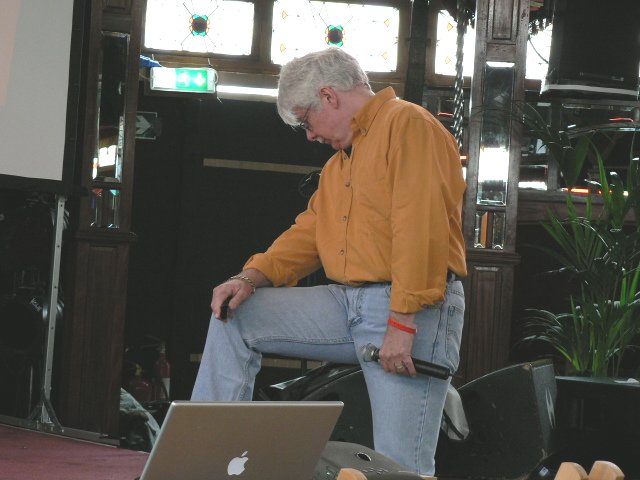
Striking a farewell pose
UncleFloyd: A great afternoon all round, and if you're reading, Ken, a big thank you from all at BowieWonderworld.
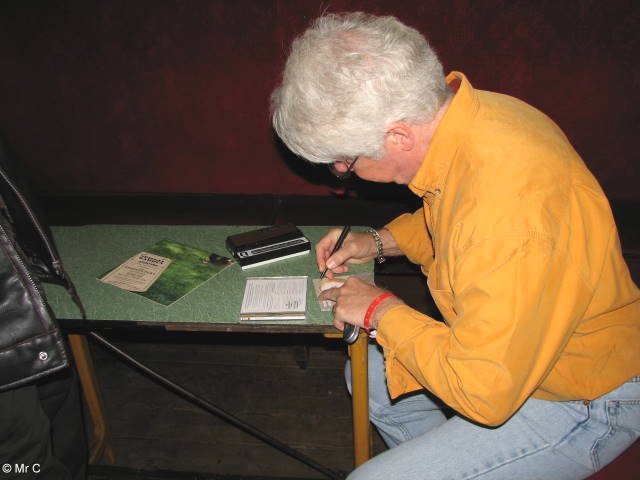
Ken signs Hunky Dory for TheLodger

Signed, sealed, delivered
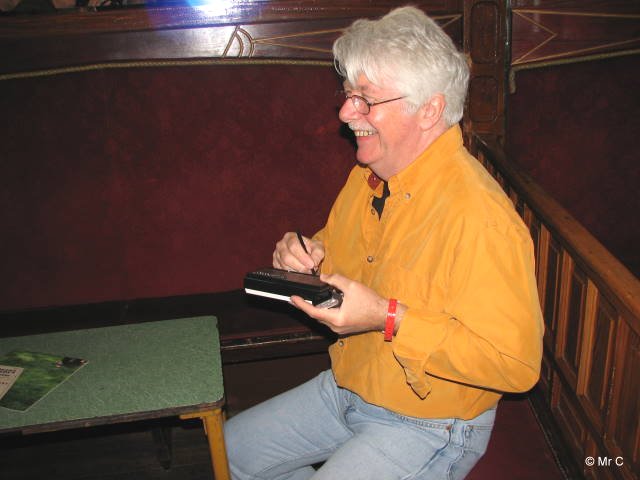
You hum it and I'll play it
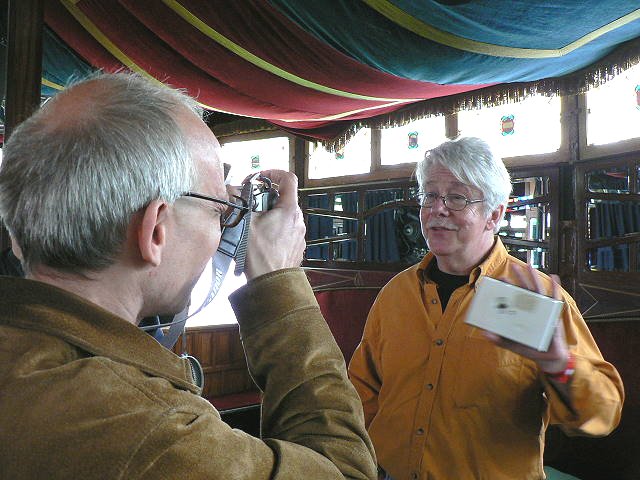
Mr C films the message to BowieWonderworld from Ken
All photographs copyright TheLodger unless otherwise stated.











